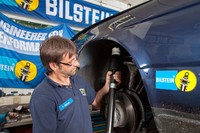Bilstein recommends a shock absorber check during springtime inspection

During the change from Winter to Summer, it’s the ideal – and cost effective - time to check the safety of your car’s chassis. Suspension damage is still something that is underestimated and technical inspection organizations in Germany such as TÜV and Dekra work on the assumption that up to 15 percent of all vehicles are driving around with defective shock absorbers. This means that literally millions of drivers are putting themselves and others at risk. In the DEKRA defect statistics, with around 20 percent, faulty suspension is the third most common technical cause of accidents after brakes and tyres. In more than half of the accidents involving vehicles that are at least ten years old with over 150,000 kilometres on the clock, defective shock absorbers are at least partly to blame. For this reason, suspension expert BILSTEIN urgently advises that not only the brakes, battery, oil level, fan belt, exhaust, tyres and wiper blades be checked during your springtime visit to the workshop, but that a closer look is also taken at the shock absorbers, which suffer a lot of wear and tear, especially in the winter.
Where shock absorber checks are concerned, BILSTEIN doesn’t only rely on the results of others; they test damping force for themselves. Once again in 2013, BILSTEIN’s mobile suspension testers were out and about all over Germany - and their findings matched up to a great extent with the statistics of the big inspection organizations. Around 20 percent of the vehicles checked by BILSTEIN had a defect in the suspension system. Both the front and rear axles were inspected. It was discovered here that as many as one in four vehicles had a road adherence difference of more than 20 percent – a sure sign of a suspension defect. Of these, the BILSTEIN experts estimate, almost one in six was attributable to faulty shock absorbers, where the ageing process takes place on the inside where it can’t be seen. Drivers therefore don’t usually notice the wear and tear until it’s much too late, if at all.
The consequences are severe, because road safety in particular is impaired when the tyres lose traction. The risk increases when cornering or taking evasive action, because the vehicle skids more easily. In addition to this, the braking distance is extended by roughly 20 percent, according to the experts. The dreaded aquaplaning effect also sets in much earlier. “A regular check of the suspension, including the shocks and springs, is essential for road safety,” emphasizes Rainer Popiol, head of training with BILSTEIN in Ennepetal. “Drivers should therefore ensure while their vehicle is in the workshop anyway that a suspension check is part of the springtime inspection”. The workshops benefit too, because the detection of possible safety risks strengthens customer loyalty, not to mention the additional turnover if the shock absorbers have to be replaced. BILSTEIN recommends that all safety-relevant vehicle parts be inspected at least every 20,000 kilometres.
For more details, visit bilstein.de.




